|
The Moons of Jupiter |
|
In the early days of science fiction, back when we hadn't explored any worlds in the solar system in quite the way we do now, the moons of Jupiter sometimes were used as imaginative settings for the antics of many a swashbuckling spaceman in search of off-world treasures and alien maidens to rescue. It's easy to see why these worlds were used as backdrops for adventure " they are so distant and " until very recently " making out features on their surfaces was a tough one for scientists. Just the names of the moons themselves sound kind of exotic... Io (EYE-oh), Europa (You-ROH-pah), Ganymede (GAN-ee-meed) and Callisto (Call-LIST-oh)... conjure up visions of Buck Rogers-type adventures on distant planetary shores. The stories written during the first Golden Age of science fiction are quaint reminders of how we once viewed the outer solar system. Today there's a new solar system out there to explore. Our explorers aren't exactly steely-jawed heroes out to rescue lissome lovelies from awesome ammonia monsters. Actually, they're robot spacecraft and orbiting observatories, operated by a new breed of spacefolk: planetary scientists " men and women who have dedicated their talents and ingenuity to the study of the planets. |
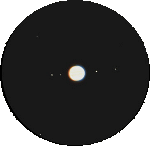
Jupiter and its moons through an 8-inch (20-cm) telescope. (Image © 1983, 1995 Loch Ness Productions. Used by permission.) |
|
The Jovian moons have been always prime targets for exploration. From Galileo's first look at them through his crude telescope in the 1600's, to the first spacecraft explorations of the 1970's and '80's (when the Pioneer and Voyager spacecraft swept past the giant planet, returning an encyclopedia's worth of images, radio data and spectroscopic observations) these worlds have captured our attention. Of course, the Pioneers and Voyagers went on to study Saturn, Uranus and Neptune, but it was at Jupiter that they first opened our eyes to the marvelous places inhabiting the region beyond the asteroid belts. |
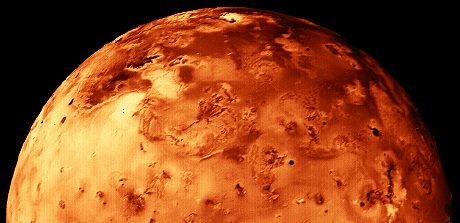
Io as imaged by Voyager 2 Image courtesy of The Nine Planets Web Page (see the Reference Library for a Link to this great site.) |
|
Io and its sister moons Europa, Ganymede and Callisto all lie within Jupiter's vast magnetic field (called its magnetosphere). They are affected in many ways by their close relationship with the giant planet, but none shows the effects more than Io. This little world orbits just under a half million kilometers above the Jovian clouds. Voyager was the first spacecraft to image Io's volcanic beauty. The images returned were color-enhanced to show the different features on Io's sulfurous surface. In the image above, you can make out cracks and flow features, along with volcanic vents. What causes all this volcanic action on such a little world? Blame it on Jupiter's tremendous gravitational field, which holds the little worlds in their orbits and serves " among other things " to force each moon to keep the same face pointed toward Jupiter at all times. Io is caught in a gravitational tug of war between Jupiter and the moon Europa. Powerful tides squeeze and flex the moon, causing interior heating. Io is a rocky body, and so its interior melts and flows out onto the surface through some 200 volcanic features. |
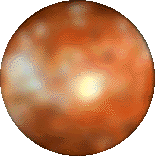 Io as imaged by Space Telescope Image courtesy of Space Telescope Science Institute |
|
Not surprisingly, the Hubble Space Telescope has looked at Io and mapped new volcanic activity on the surface. From its orbit high above the earth, the telescope returned images that could have come from Voyager when the spacecraft was only a few million kilometers away from the planet. Unlike the Voyager spacecraft, however, HST can turn its gaze to Io again and again, studying the little world as it changes. |
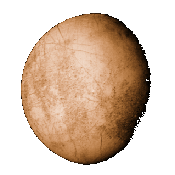
Europa as seen by Voyager 2 Image courtesy of The Nine Planets Web Page. |
|
In Arthur C. Clark's novel, 2010, the story ends with a warning to humans ready to explore the Jovian moons: "All these worlds are yours " except Europa. Attempt no landings there." In the next book, we learn that life has made a foothold on this icy-looking world. Science fiction or science fact? Surprisingly, it is possible that life could exist in water oceans beneath the thin ice crust of this little moon. Is it probable? We don't know. What we do know is that Europa is a rocky body covered with a 25 kilometer thick layer of ice, or perhaps an ocean with a thin, smooth and surprisingly young ice crust riding on top. How do we know it's young? There are few craters marring the surface, which means that somehow, Europa is smoothing out its complexion from below. That implies heating from within, and that heating may have melted some of the ice beneath the surface to form an ocean. |
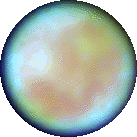
Europa from Hubble Space Telescope Image courtesy The Nine Planets Web Page. |
|
As you might guess, Hubble Space Telescope has checked out Europa also. Remember that this image is taken from a distance of about 800,000,000 kilometers from the moon, but is about equivalent to a Voyager image taken a few million kilometers away from the moon during the 1979 and 1980 flybys. Hubble's scans of this little moon have revealed a tenuous oxygen atmosphere hovering above the glazed ice surface. |
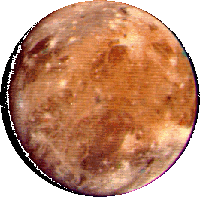
Ganymede from Voyager Image courtesy The Nine Planets Web Page |
|
Ganymede is the largest moon in the Solar System " a half-rock, half-ice world that orbits just over a million kilometers away from Jupiter. Voyager revealed it to be a world scarred by surface grooves and ridges, and pockmarked with old heavily-cratered regions. As with Io and Europa, Voyager's images have been color-enhanced to show up these features and help planetary scientists understand what's going on with this moon. |
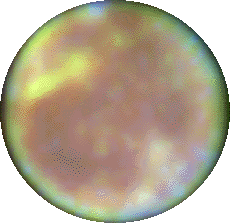
Ganymede as seen by HST Image courtesy of the Space Telescope Science Institute. |
|
When Hubble Space Telescope looked at Ganymede, it found traces of ozone close to the surface. It appears that this ozone layer is being produced when charged particles are swept along by Jupiter's magnetic field and slammed into the icy surface of this moon. There they interact with the ice, and ozone may be produced when they do. The image above was produced as part of a set of studies of the Jovian moons. |
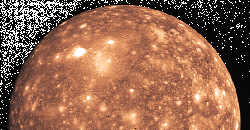
Callisto from Voyager Image courtesy of The Nine Planets Web Page. |
|
Callisto is the outermost of Jupiter's four Galilean moons, and the one with the oldest, most-scarred surface. Like Ganymede, Callisto is mostly ice " probably water ice " surrounding a small, rocky core. Just by looking at it, you can tell that this is a battered world. Wherever something collided with the surface, ice splashed out across the dark terrain. |
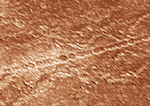
A string of craters on Callisto's surface Image courtesy The Nine Planets Web Page. |
|
One of the more intriguing finds on Callisto is the set of craters seen in the image below. It appears as though a string of objects hit Callisto's surface sometime in the distant past. It's reminiscent of the "string of pearls" comet which had a fatal encounter with Jupiter in 1994. |
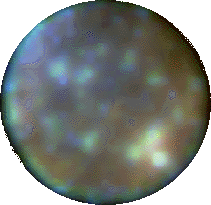
Callisto from Hubble Space Telescope. Image courtesy of the Space Telescope Science Institute. |
|
Hubble's observations of Callisto took advantage of the telescope's ability to do imaging in ultraviolet wavelengths of light. While studying this moon and producing the image you see here, the telescope also found evidence of fresh ice on the surface of this moon. That means something is "gardening" the surface in some way, and one likely explanation is a bombardment by micrometeorites " which plow into the surface and churn up fresh ice. Voyager certainly opened our eyes to the wonders of these worlds, and Hubble Space Telescope will continue to study them as part of its planetary science mission. The last big spacecraft encounter for Jupiter and its moons began in Fall 1995 when the Galileo spacecraft entered Jovian "space". It has studied Jupiter and its moons, and is slowly returning data to Earth. Galileo is scheduled to plunge into Jupiter's atmosphere in late 2003, and what we have learned from its extended mission is an invaluable addition to our ever-growing storehouse of planetary science. To go back to the Gallery simply close this window. |